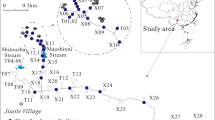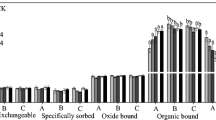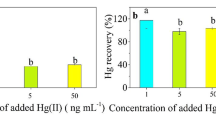Abstract
Mercury (Hg) is a global pollutant and can be accumulated in the food chain, posing exposure risks to humans. In this study, rice plants and corresponding rhizosphere soil samples were collected from a watershed of the Wawu River Basin that is heavily impacted by historic Hg mining and retorting activities. Total mercury (THg) and methylmercury (MeHg) in rice grains, as well as other tissues and soil samples, were measured. Five soil Hg fractions, as well as soil parameters, were also determined. The results show that the average concentrations of THg and MeHg in rice grains were 14 ± 7.0 μg kg−1 and 7.2 ± 4.0 μg kg−1. Soil organic-bound (Hg-o) and strong complex-bound (Hg-s) were the main Hg fractions, accounting for 44% of the total. To estimate the Hg–ligand interaction in the soils, soil -N/Hg (R = 0.451, p < 0.05), -S/Hg (R = 0.372, p < 0.1), and -OM/Hg ratio (R = 0.320, p < 0.5) with MeHgsoil were observed with significant positive correlations, indicating that the formation of Hg–OM, Hg–N–OM or Hg–S–OM complexes could prevent Hg(II) from methylation in soils. The significant positive correlations of the -N/Hg ratio, -S/Hg ratio and -OM/Hg ratio with MeHg in rice tissues suggested that Hg methylation and MeHg demethylation occurred throughout the rice paddy ecosystem. The estimated MeHg daily intake (EDI) was 0.075 ± 0.041 μg kg−1 bw d−1 and was lower than the RfD level of 0.1 μg kg−1 bw d−1 recommended by the US EPA. However, approximately 29% of the hazardous index (HI) of MeHg in grain exceeded 1, posing a potential threat to local populations, particularly pregnant women and children.






Similar content being viewed by others
References
Bloom NS, Preus E, Katon J, Hiltner M (2003) Selective extractions to assess the biogeochemically relevant fractionation of inorganic mercury in sediments and soils. Anal Chim Acta 479(2):233–248
Boszke L, Kowalski A, Szczuciński W, Rachlewicz G, Lorenc S, Siepak J (2006) Assessment of mercury mobility and bioavailability by fractionation method in sediments from coastal zone inundated by the 26 December 2004 tsunami in Thailand. Environ Geol 51(4):527–536
Cao H, Chen J, Zhang J, Zhang H, Qiao L, Men Y (2010) Heavy metals in rice and garden vegetables and their potential health risks to inhabitants in the vicinity of an industrial zone in Jiangsu, China. J Environ Sci 22(11):1792–1799
Clarkson TW (2002) The three modern faces of mercury. Environ Health Perspect 110(Suppl 1):11–23
Covelli S, Acquavita A, Piani R, Predonzani S, Vittor CD (2009) Recent contamination of mercury in an estuarine environment (Marano Lagoon, Northern Adriatic, Italy). Estuar Coast Shelf Sci 82(2):273–284
FAO (2002) World agriculture: towards 2015/2030. Summary report. Food and Agriculture Organization of the United Nations, Rome. ISBN 92-5-104826-6
Fay L, Gustin M (2007) Assessing the influence of different atmospheric and soil mercury concentrations on foliar mercury concentrations in a controlled environment. Water Air Soil Pollut 181(1–4):373–384
Feng X, Li P, Qiu G, Wang S, Li G, Shang L et al (2008) Human exposure to methylmercury through rice intake in mercury mining areas, Guizhou Province, China. Environ Sci Technol 42(1):326–332
Feng X, Qiu G, Wang S (2013) Risk assessments and exposure pathways of inorganic mercury and methylmercury to populations from mercury mining regions in China. Geochimica 42(3):205–211
Fleming EJ, Mack EE, Green PG, Nelson DC (2006) Mercury methylation from unexpected sources: molybdate-inhibited freshwater sediments and an iron-reducing bacterium. Appl Environ Microbiol 72(1):457–464
Food and Agriculture Organization of the United Nations (FAO) (2006) Rice is life. FAO, Rome
Gilmour CC, Henry EA, Mitchell R (1992) Sulfate stimulation of mercury methylation in freshwater sediments. Environ Sci Technol 26(11):2281–2287
Gnamuš A, Byrne AR, Horvat M (2000) Mercury in the soil–plant–deer–predator food chain of a temperate forest in Slovenia. Environ Sci Technol 34(16):3337–3345
Graham AM, Aiken GR, Gilmour CC (2012) Dissolved organic matter enhances microbial mercury methylation under sulfidic conditions. Environ Sci Technol 46(5):2715–2723
International Rice Research Institute (IRRI) (2012) World rice statistics. IRRI, Los Banos
Issaro N, Abi-Ghanem C, Bermond A (2009) Fractionation studies of mercury in soils and sediments: a review of the chemical reagents used for mercury extraction. Anal Chim Acta 631(1):1–12
Joint FAO/WHO Expert Committee on Food Additives (JECFA). Food and Agriculture Organization of the United Nations, Rome, Italy, 2010, pp 1–16
Li P, Feng X, Shang L, Qiu G, Meng B, Liang P, Zhang H (2008a) Mercury pollution from artisanal mercury mining in Tongren, Guizhou, China. Appl Geochem 23(8):2055–2064
Li P, Feng X, Qiu G, Shang L, Wang S (2008b) Mercury exposure in the population from Wuchuan mercury mining area, Guizhou, China. Sci Total Environ 395(2–3):72–79
Li P, Feng X, Qiu G, Shang L, Wang S, Meng B (2009) Atmospheric mercury emission from artisanal mercury mining in Guizhou Province, Southwestern China. Atmos Environ 43(14):2247–2251
Li P, Feng X, Yuan X, Chan HM, Qiu G, Sun GX, Zhu YG (2012) Rice consumption contributes to low level methylmercury exposure in Southern China. Environ Int 49:18–23
Liang L, Bloom NS, Horvat M (1994) Simultaneous determination of mercury speciation in biological materials by GC/CVAFS after ethylation and room-temperature precollection. Clin Chem 40(4):602–607
Liang L, Horvat M, Cernichiari E, Gelein B, Balogh S (1996) Simple solvent extraction technique for elimination of matrix interferences in the determination of methylmercury in environmental and biological samples by ethylation-gas chromatography–cold vapor atomic fluorescence spectrometry. Talanta 43(11):1883–1888
Lin LY, Chang LF, Jiang SJ (2008) Speciation analysis of mercury in cereals by liquid chromatography chemical vapor generation inductively coupled plasma-mass spectrometry. J Agric Food Chem 56(16):6868–6872
Lin Y, Larssen T, Vogt RD, Feng X (2010) Identification of fractions of mercury in water, soil and sediment from a typical Hg mining area in Wanshan, Guizhou Province, China. Appl Geochem 25(1):60–68
Lindqvist O, Johansson K, Bringmark L, Timm B, Aastrup M, Andersson A, Meili M (1991) Mercury in the Swedish environment—recent research on causes, consequences and corrective methods. Water Air Soil Pollut 55(1–2):xi–xi261
Liu YR, Yu RQ, Zheng YM, He JZ (2014) Analysis of community structure of Hg methylation gene (hgcA) in paddy soils along an Hg gradient. Appl Environ Microbiol. https://doi.org/10.1128/AEM.04225-13
Meng B, Feng X, Qiu G, Cai Y, Wang D, Li P et al (2010) Distribution patterns of inorganic mercury and methylmercury in tissues of rice (Oryza sativa L.) plants and possible bioaccumulation pathways. J Agric Food Chem 58(8):4951–4958
Meng B, Feng X, Qiu G, Liang P, Li P, Chen C, Shang L (2011) The process of methylmercury accumulation in rice (Oryza sativa L.). Environ Sci Technol 45(7):2711–2717
Meng B, Feng X, Qiu G, Wang D, Liang P, Li P, Shang L (2012) Inorganic mercury accumulation in rice (Oryza sativa L.). Environ Toxicol Chem 31(9):2093–2098
Meng M, Li B, Shao JJ, Wang T, He B, Shi JB et al (2014) Accumulation of total mercury and methylmercury in rice plants collected from different mining areas in China. Environ Pollut 184(1):179–186
Mergler D, Anderson HA, Chan LHM, Mahaffey KR, Murray M, Sakamoto M, Stern AH (2007) Methylmercury exposure and health effects in humans: a worldwide concern. AMBIO J Hum Environ 36(1):3–11
Qiu G, Feng X, Wang S, Shang L (2005a) Mercury and methylmercury in riparian soil, sediments, mine-waste calcines, and moss from abandoned Hg mines in east Guizhou Province, Southwestern China. Appl Geochem 20(3):627–638
Qiu GL, Feng XB, Liang L, Shang LH, He TR, Yan HY et al (2005b) Determination of methylmercury in moss by ethylation-gas chromatography–cold vapor atomic fluorescence spectrometry with solvent extraction. J Instrum Anal 24(1):29–32
Qiu G, Feng X, Wang S, Shang L (2006) Environmental contamination of mercury from Hg-mining areas in Wuchuan, northeastern Guizhou, China. Environ Pollut 142(3):549–558
Qiu G, Feng X, Li P, Wang S, Li G, Shang L, Fu X (2008) Methylmercury accumulation in rice (Oryza sativa L.) grown at abandoned mercury mines in Guizhou, China. J Agric Food Chem 56(7):2465–2468
Qu L (2004) A study on prevention and remedy of Hg contamination in Guizhou. Guizhou Press, Guiyang, pp 1–251
Rothenberg SE, Feng X, Dong B, Shang L, Yin R, Yuan X (2011) Characterization of mercury species in brown and white rice (Oryza sativa L.) grown in water-saving paddies. Environ Pollut 159(5):1283–1289
Schuster E (1991) The behavior of mercury in the soil with special emphasis on complexation and adsorption processes—a review of the literature. Water Air Soil Pollut 56(1):667–680
Skyllberg U, Drott A (2010) Competition between disordered iron sulfide and natural organic matter associated thiols for mercury(II): an EXAFS study. Environ Sci Technol 44(4):1254–1259
Skyllberg U, Bloom PR, Qian J, Lin CM, Bleam WF (2006) Complexation of mercury(II) in soil organic matter: EXAFS evidence for linear two-coordination with reduced sulfur groups. Environ Sci Technol 40(13):4174–4180
Stein ED, Cohen Y, Winer AM (1996) Environmental distribution and transformation of mercury compounds. Crit Rev Environ Sci Technol 26(1):1–43
Tan H, He J, Lindqvist O, Xiao Z (1997) Mercury emission from its production in Guizhou Province, China. Guizhou Sci China 15(2):112–117
Ullrich SM, Tanton TW, Abdrashitova SA (2001) Mercury in the aquatic environment: a review of factors affecting methylation. Crit Rev Environ Sci Technol 31(3):241–293
US EPA (1997) Mercury study report to Congress. ORD, EPA-452/R-97-003
US EPA (1998) Guidelines for ecological risk assessment. In: Risk Assessment Forum, May 1998
US EPA (2001) Method 1630: methylmercury in water by distillate, aqueous ethylation, purge and trap, and CVAFS. Draft, Jan 2001. U.S. Environmental Protection Agency, Office of Water, Office of Science and Technology Engineering and Analysis Division, Washington, DC, pp 1–41
US EPA (2002) Method 1631, revision E: mercury in water by oxidation, purge and trap, and cold vapor atomic fluorescence spectrometry. EPA-821-R-02-019
Wallschläger D, Desai MV, Spengler M, Wilken RD (1998) Mercury speciation in floodplain soils and sediments along a contaminated river transect. J Environ Qual 27(5):1034–1044
WHO (1990) Methylmercury environmental health criteria 101. World Health Organization, Geneva, pp 1–144
Wu C, Wu G, Wang Z, Zhang Z, Qian Y, Ju L (2018) Soil mercury speciation and accumulation in rice (Oryza sativa L.) grown in wastewater-irrigated farms. Appl Geochem 89:202–209
Yin D, He T, Yin R, Zeng L (2018) Effects of soil properties on production and bioaccumulation of methylmercury in rice paddies at a mercury mining area, China. J Environ Sci 68(6):194
Zhang H, Feng X, Larssen T, Shang L, Li P (2010a) Bioaccumulation of methylmercury versus inorganic mercury in rice (Oryza sativa L.) grain. Environ Sci Technol 44(12):4499–4504
Zhang H, Feng X, Larssen T, Qiu G, Vogt RD (2010b) In inland China, rice, rather than fish, is the major pathway for methylmercury exposure. Environ Health Perspect 118(9):1183
Zhang H, Feng X, Larssen T, Shang L, Vogt RD, Lin Y et al (2010c) Fractionation, distribution and transport of mercury in rivers and tributaries around Wanshan Hg Mining District, Guizhou Province, Southwestern China: part 2—methylmercury. Appl Geochem 25(5):642–649
Zhang H, Feng X, Zhu J, Sapkota A, Meng B, Yao H et al (2012) Selenium in soil inhibits mercury uptake and translocation in rice (Oryza sativa L.). Environ Sci Technol 46(18):10040–10046
Zhao L, Anderson CW, Qiu G, Meng B, Wang D, Feng X (2016) Mercury methylation in paddy soil: source and distribution of mercury species at a Hg mining area, Guizhou Province, China. Biogeosciences 13(8):2429–2440
Zhou J, Liu H, Du B, Shang L, Yang J, Wang Y (2015) Influence of soil mercury concentration and fraction on bioaccumulation process of inorganic mercury and methylmercury in rice (Oryza sativa L.). Environ Sci Pollut Res 22(8):6144–6154
Acknowledgements
Financial support for this work was provided by the National Natural Science Foundation of China (NSFC: 21767007), and the Science and Technological Program of Guizhou (2018-1111).
Author information
Authors and Affiliations
Corresponding author
Rights and permissions
About this article
Cite this article
Pang, J., Han, J., Fan, X. et al. Mercury speciation, bioavailability and risk assessment on soil–rice systems from a watershed impacted by abandoned Hg mine-waste tailings. Acta Geochim 38, 391–403 (2019). https://doi.org/10.1007/s11631-018-0305-4
Received:
Revised:
Accepted:
Published:
Issue Date:
DOI: https://doi.org/10.1007/s11631-018-0305-4




